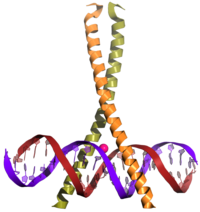bZIP domain
The bZIP domain , also known as the leucine zipper , is a protein domain that is found in many eukaryotic DNA binding proteins and is used for the dimerization of proteins . The abbreviation stands for Basic Leucine Zipper Domain , as part of this region contains many basic amino acids , such as lysine and arginine .
A bZIP domain consists of an α-helix in which every first and fourth seven amino acid - often a leucine - is hydrophobic . This is often referred to as the heptad pattern .
If two of these domains from two proteins come into contact, both homo- and hetero- dimers can form. The leucines accumulate in the hydrophilic environment due to hydrophobic interactions . Since the following leucines are not 100% in a straight line, the two alpha helices wind themselves into a left-handed super-helix ( coiled coil ). The twisting stops at the DNA binding region and forms a fork, the superhelix arms are slightly apart, so that the positively charged amino acids arginine and lysine , which are frequently found here, bind to the negatively charged phosphate backbone of the DNA.
Proteins with the bZIP domain
- AP-1 Fos / Jun - a heterodimer that forms a transcription factor
- C / EBPs - transcription factors
- CREB - cAMP response element binding protein - a transcription factor
- Jun-B - transcription factor
literature
- William H. Landschulz, Peter F. Johnson, Steven L. McKnight : The leucine zipper: a hypothetical structure common to a new class of DNA-binding proteins. In: Science . Vol. 240, No. 4860, 1988, pp. 1759-1764, doi : 10.1126 / science.3289117 , PMID 3289117 .
